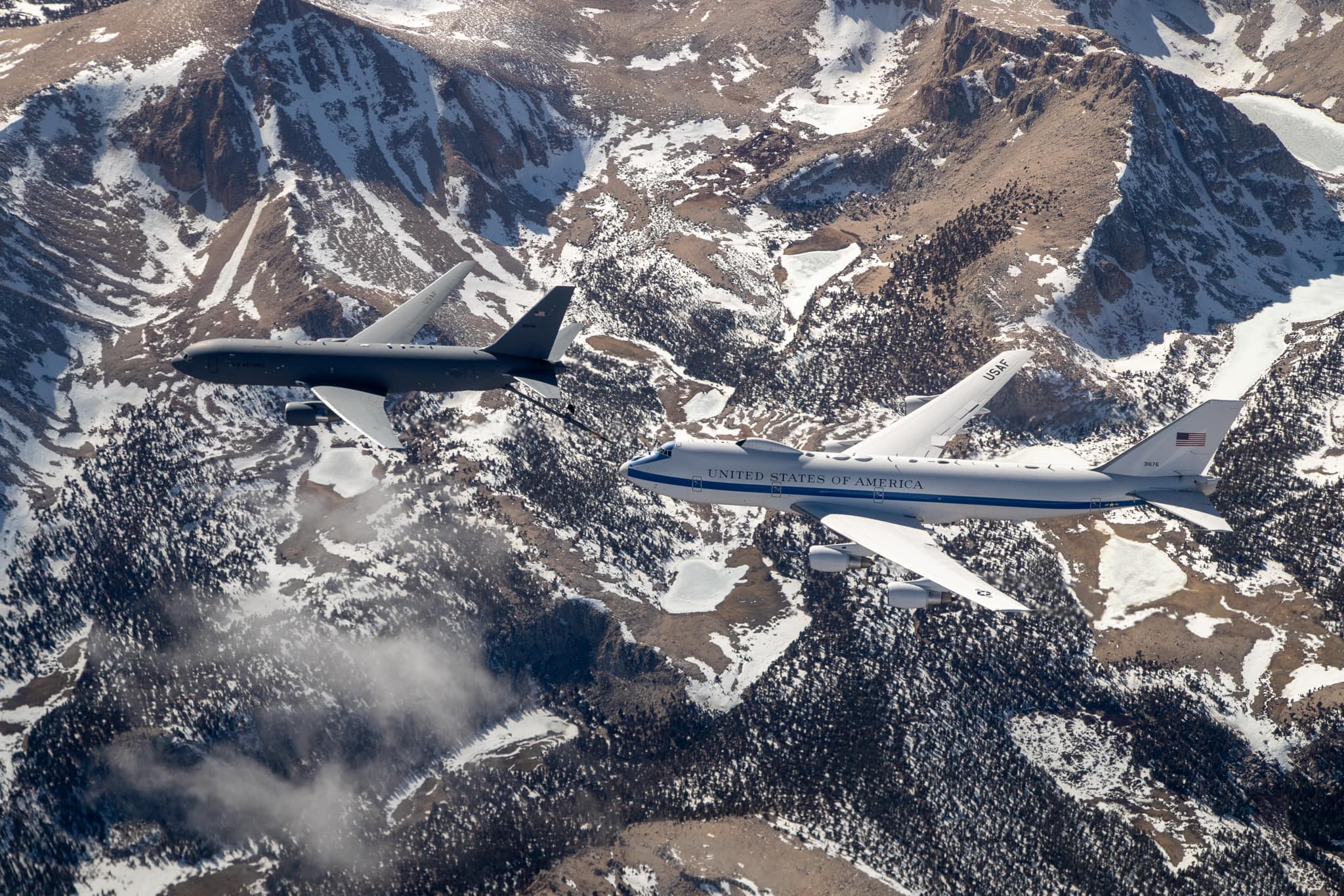High above a snow-capped Southern California mountain range on April 29, the KC-46 Pegasus successfully carried out aerial refueling trials with the E-4B Nightwatch. This resulted in a pair of gorgeous shots that showcase the E-4B’s highly modified spine that is festooned with antennas of many types. The E-4B’s top half has changed over the years as new communications tech was inserted into the airframe, leaving not much real estate left up there. The images also show the glaring size difference between the KC-46A and the E-4B, which are derived from the Boeing 767 and 747 airliners, respectively.
The KC-46A remains under test at Edwards Air Force Base in California. The E-4B used in the test is based at Offutt Air Force Base in Nebraska, although the fleet has relocated to Lincoln, Nebraska, while Offutt’s runway is being rebuilt.

Serving as the U.S. Air Force’s partial answer to its aging tanker fleet, the KC-46A Pegasus has been in development since February 2011 with its inaugural flight having taken place in December 2014. The aircraft has since been undergoing numerous tests in what has become an arduous journey to reach its promised potential.
A huge swathe of issues continued to plague the aircraft after its first delivery to an operational unit in 2019. Above all else, ongoing challenges with the aircraft’s critical Remote Vision System (RVS) have prevented the Pegasus from effectively carrying out the full scope of its intended mission.
However, the USAF is making it clear that they refuse to give up on their new tanker, and with many dozens already delivered, they really don’t have a choice. After having been described as a “lemon” that the USAF hopes to eventually make lemonade out of, the Pegasus has since been qualified to refuel numerous aircraft, although with a number of restrictions that make it less than fully combat-capable. It is hoped that a fix for the RVS is available sometime in 2026, at the soonest.
While the Pegasus’ legacy is just beginning, the E-4B’s is gradually coming to an end. Evolved from the E-4A, examples of which began to enter service in 1974, the first B variant was delivered to the USAF in January 1980. All four of the E-4s were subsequently upgraded to the ‘B’ configuration.
Also now known as National Airborne Operations Centers, or NAOCs, the aging Nightwatch fleet of 747-200-based jets is now on its way to being replaced via the fledgling Survivable Airborne Operations Center program.
One would expect that retaining the aircraft’s aerial refueling capability will be a huge priority for the USAF as it is critical to the Nightwatch’s core mission. The E-4B is often referred to as the “Doomsday Plane” because it would serve as a command and control center for top Pentagon officials, and even the President, during a nuclear crisis or other major continuity of government event. During such a contingency, the plane could stay airborne for a number of days straight. Doing so requires many aerial refuelings, making it paramount that the E-4B is compatible with the Pegasus.
As far as potential E-4B replacements are concerned, the USAF insists that it will need four engines to meet mission requirements. While the gritty details of those requirements remain classified, it is likely that the ubiquitous Boeing 747 is the only option when considering the number of engines required, let alone the interior size needed.
The good news is that much of the work being done on the future Air Force One VC-25B airframes should be able to be adapted to a future 747-8i-based E-4B replacement aircraft. Those airframes may have to be bought used though, as the 747 is going out of production once and for all. One thing that will need to be developed, though, is aerial refueling for the 747-8i sub-type. As it sits now, the VC-25Bs will go without this critical feature.
It’s possible that the recent trials carried out between the KC-46A and E-4B will also lead to the VC-25As —the current “Air Force One” aircraft — being cleared to receive fuel from the Pegasuses, as well. The VC-25As are based on the same 747-200 airframe as the E-4Bs and they feature the same refueling receptacle.
Regardless, the E-4B remains one of the most striking and iconic aircraft flying today. So we should appreciate these awesome shots while we can considering ‘Nightwatch’ is now entering the twilight of its operational service.
Contact the authors: Emma@thewarzone.com and Tyler@thedrive.com
